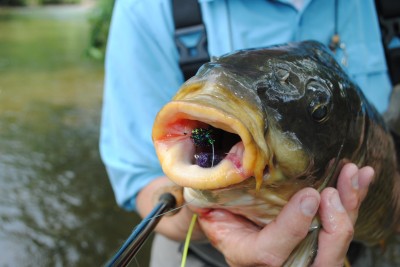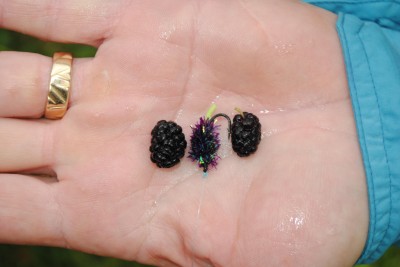Mulberry Flies for Michigan Carp
Bob Gwizdz 08.20.13

I’d been standing in one place for at least 10 minutes, about 35 yards downstream from a mulberry tree, watching the carp mill around the overhanging branches on the Huron River outside Ann Arbor, Michigan. I noticed a fish come out from the bank and settle in slightly deeper water, so I shot a roll cast upstream from it a bit and when I saw the fish come up in the water column toward my slowly sinking purple fly, I set the hook.
It exploded out of the shallows like a nitro-burning dragster and shot all the way across the river to the other bank. I hollered to my partner, Dirk Fischbach, who was fishing maybe 75 yards downstream from me, that I’d hooked up.
The fish took me under a log and through a brush pile, but apparently I’d hooked it well as I was able to get my rod under the log and move up on the fish, which was still taking drag. Fischbach caught up with me and grabbed a branch from the brush pile, freeing my floating line, and the fish went back out into the river channel. From there, it was just a tug of war.
Twenty minutes after it started, Fischbach held my prize for photographs.
I’ve heard for years about fly fishing for carp feeding on mulberries. Apparently, it was all true.
Fischbach, co-owner of Colton Bay Outfitters in Ann Arbor and my sometimes-fly fishing partner over the course of the last couple of decades, has been into the mulberry bite for a while. As he explains it, it starts in mid-June, when the fruit begins dropping, and lasts all summer long.

“Once they’re on the berries they will stay on them,” Fischbach said. “You can catch them into September.”
The nice thing about mulberries, Fischbach said, is that the fruit doesn’t all ripen at once. The “hatch” lasts for weeks. Fischbach says he likes to fish below trees that have birds or squirrels in them as, as the critters knock berries into the water, the fish turn on. Often the bite is well below the tree.
“It’s very similar to fishing spent spinners for trout,” Fischbach explained. “The big fish want to hang in the logical collection points where the current is going to force the berries together. “
As I photographed my fish, I noticed it had a second mulberry fly in its mouth. Someone had hooked this fish and broken off. Fischbach said fishing gets tougher as the carp get pressured.
“It’s like any major hatch on a trout stream; the first few days are the best,” said Fischbach, whose best day on the Huron River was eight carp, early in the season. “As guys get out there doing it, the fish get smarter.
“These fish have seen a lot.”
Carp fishing, which has become all that on the flats in Grand Traverse Bay and other Great Lakes’ bays in recent years, is much more difficult than you might think.
“They’re extremely spooky,” said Fischbach, 51, and a fly fishing guide (mostly for smallmouth bass) since the mid-1980s. “They’re the smartest fish I’ve ever fished for, absolutely.
“It’s a fairly fine style of fishing,” he continued. “The presentation and drift are really important. It is not an easy game. You’re going to have to work for it. Dropping the fly where it needs to be is critical.”
Fischbach says you can have hard time hooking carp unless you see them take the fly.

“You can do it with an indicator rig, but they’re so quick on the spit, that you really need to see their mouth go on it,” he said. “It’s a very visual game.”
As we let the fish go, it started to rain. We sought shelter under an overhang in the park and the skies opened up. It poured–thunder, lightning, the whole nine yards–for an hour. The river came up dramatically and it looked more suitable for plowing than fishing. Fischbach got on the phone, found that the rain hadn’t hit to the south, and we loaded up to go try the Saline River. But between Ann Arbor and Saline, we caught up with the storm and that river was cooked, too.
Meanwhile, Fischbach described the fly: he ties it on a No. 6 bonefish hook, under-wrapped with closed-cell foam. He puts a little green stem on it (he prefers rubber leg material) and finishes it with purple cactus chenille as the main body.
“Some guys us Estaz, but the chenille is cheaper,” he said. “You can tie them out of deer hair, but it’s so light that the carp push it away when they come up to take it.”
I was using an 8-weight rod and leader that Fischbach tied with a 30-pound butt section, a 20-pound length, and a 12-pound tippet.
“In real clear water you may have to go a little lighter than that,” Fischbach said. .”But you’re talking about big fish. A small one is going to run eight pounds. A big one is going to go 20. The average is between 12 and 15. They’re big boys–24 or 25 inches is not uncommon–and the way they’re built, that’s a lot of fish.”
Fischbach says he prefers a fiberglass rod for this game because it’s tough.
“And you’ve got to have a reel with good drag,” he said. “They run as hard as anything.”
You can reach Fischbach at Colton Bay Outfitters at (734) 222-9776.
For more information on Michigan fishing go to michigan.org. Click here to purchase a Michigan fishing license online.

